Key Takeaways for Taming Scope Creep
- Crystal Clear Documentation: Vague plans invite trouble. Detailed bid packages and RFPs are your first line of defense.
- Formal Change Management: Changes happen, but they need strict protocols. Document, price, and approve every single modification.
- Integrated Technology is a Game Changer: Tools like Archdesk connect every stage, ensuring everyone works from a single source of truth.
You know that moment. The project is humming along, everything’s on schedule, and then a client casually mentions, "Oh, while you're at it, could we just...?" That seemingly small request, that little tweak, often marks the beginning of a creeping problem. It’s what we call "scope creep," and honestly, it’s a budget-killer and a timeline-wrecker. It sneaks up on even the most seasoned construction pros, turning a profitable venture into a headache. But here’s the thing: it doesn't have to be that way.
The real secret isn’t just reacting to changes; it’s building a fortress against them right from the start. This means getting things right long before the first shovel hits the dirt, in how you craft your bid packages, perfect your Requests for Proposals (RFPs), and master your change orders. Let’s break it down.
The Foundation: Bid Packages That Mean Business
Setting the Stage for Success, Not Surprises
Think of your bid package as the absolute blueprint for your entire relationship with a subcontractor. If it’s vague, you're practically inviting confusion. If it’s precise, you're building on rock-solid ground. A tight bid package does so much more than just list tasks; it defines the very edges of the work. It answers those "what if" questions before they even get asked. This is where you specify exact materials, model numbers, quality standards—you name it. Any ambiguity here is like leaving the door wide open for scope creep to just waltz in later. You want your subcontractors bidding on the exact same vision you have, eliminating those costly assumptions that always seem to surface halfway through a job, don't you?
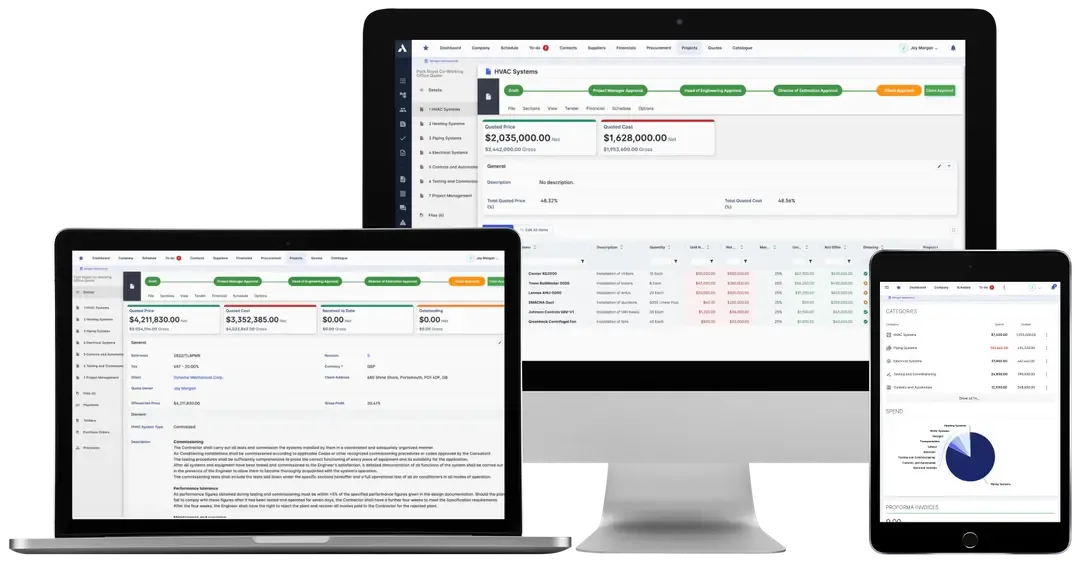
An example of a detailed bid package or project overview within a construction management platform.
Detailing the Scope: No Room for Guesswork
For instance, if you're working on a commercial build, your bid package should include everything from site prep details down to the last cubic yard of dirt. Miss that, and you might find yourself in a heated debate over unforeseen extras mid-project. It's about being painstakingly detailed upfront. This level of clarity significantly cuts down on assumptions that almost always lead to creep. Honestly, a vague bid is a bit like inviting guests to a party without telling them when it ends; things can get messy fast.
This is where Archdesk really shines. It helps you build comprehensive bid packages using templates that can auto-fill costs and specifications. Unlike some bulkier options, like Procore, which sometimes feels overwhelming for smaller teams, Archdesk keeps things streamlined. It helps you track bids without all the extra fluff, integrating live bidding too, so you get responses that truly stick to your defined scope. It’s about making sure everyone is singing from the same hymn sheet, right from the first note.
The Blueprint: Crafting RFPs That Actually Deliver
Your Clear Call for the Right Partners
An RFP shouldn't feel like a scavenger hunt for potential partners. It’s your golden opportunity to be absolutely crystal clear about what you need and, just as importantly, what you absolutely don't. A well-written RFP sets the entire tone for the project. It acts like a filter, helping you find partners who actually read the details and weeding out those who bid low, secretly hoping to make up the difference on changes later.
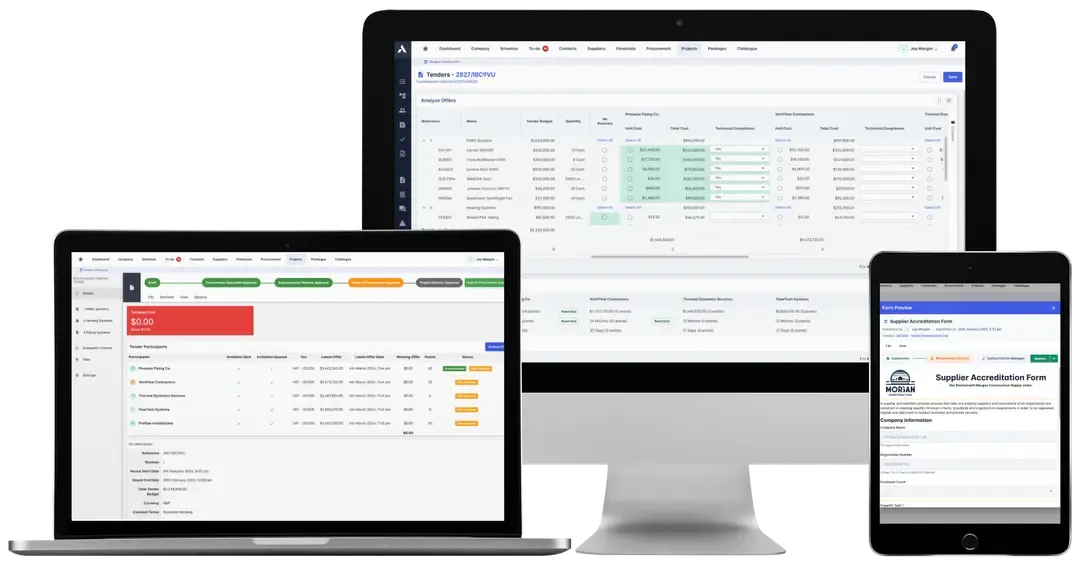
A visual representation of a commercial construction RFP template, showcasing sections for detailed requirements.
Defining Objectives and Expectations
Be brutally honest about project constraints—things like budget, timeline, and site conditions. This transparency isn't a sign of weakness; it’s a mark of true professionalism. It allows companies to provide realistic proposals and solid plans from day one. When everyone's expectations are perfectly aligned from the very beginning, there’s simply less room for those unwelcome "surprises" down the line. A good RFP specifies what's needed, including costs, materials, and labor – the whole picture. Using clear language and avoiding overly technical jargon (unless it's absolutely necessary) helps ensure everyone understands the project requirements. This means giving plenty of detail so bidders know exactly what they're signing up for. If the project scope and requirements aren’t clearly outlined during the RFP process, it's pretty much an open invitation for extra tasks to be added without any budget or timeline adjustments. That’s a recipe for disaster, honestly.
Ever had an RFP come back with bids that seem to reinterpret your needs entirely? Frustrating, right? This often happens when you skip over the fine print. To keep everyone honest, consider tying in milestones and even penalties for major deviations. Here, Archdesk’s proposal tools are invaluable, letting you customize RFPs with automated pricing, ensuring bids align perfectly with your vision. It really is a step up from platforms where the focus might be more on design, leaving just enough room for misinterpretation.
The Reality: Change Orders Are Inevitable (Manage Them Well)
Turning Potential Problems into Controlled Adjustments
Let's be real. Changes happen. Unexpected soil conditions, evolving client desires, or sometimes, the original plan just needs a little tweak. The goal isn't to avoid change orders entirely; that's just a fantasy. The goal is to control them effectively. A formal change order process is your absolute best friend here. It forces a pause—a deliberate conversation about the actual impact of a change on cost, schedule, and resources. No more verbal approvals or casual emails. Every change must be documented, priced, and signed off on before any work even begins. This isn't about bureaucracy; it’s about respecting the project's budget and timeline. It protects you from eating costs and keeps the client fully aware of the consequences of their decisions.
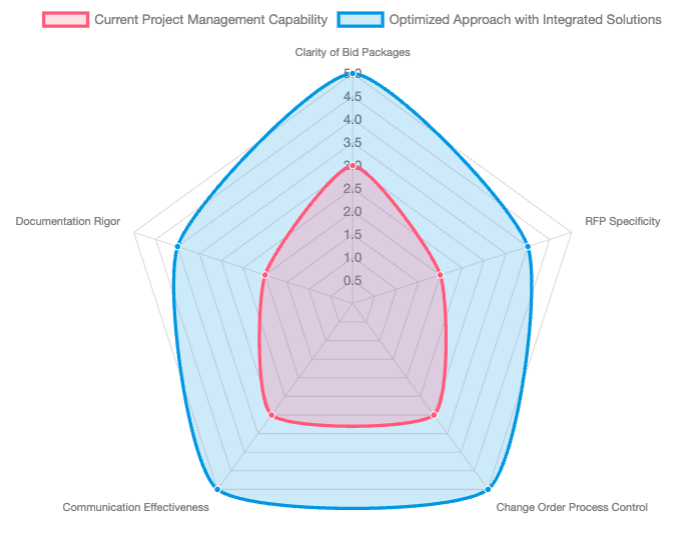
This radar chart illustrates the impact of adopting optimized practices and integrated solutions on key aspects of project management crucial for preventing scope creep. The scale of 1 to 5 represents the level of effectiveness, with 5 being the highest.
Formal Processes: Your Shield Against Chaos
This is where the right tools truly make all the difference. Managing this complex process with a scattered mess of emails, spreadsheets, and paper forms is a recipe for missed details and lost profits. A centralized platform that tracks every request, documents every approval, and updates your project budget in real time is no longer a luxury—it’s a necessity. This is what Archdesk was built to do. It brings clarity to the chaos. While other platforms like Procore or Autodesk Construction Cloud offer change order modules, Archdesk focuses on weaving it into the entire project lifecycle. Your bid packages, RFP responses, and change orders aren't isolated documents; they're truly connected threads. You can see how a single change ripples through your budget and schedule instantly, allowing for smarter, more informed decisions. It’s all about having a single source of truth that everyone can trust.
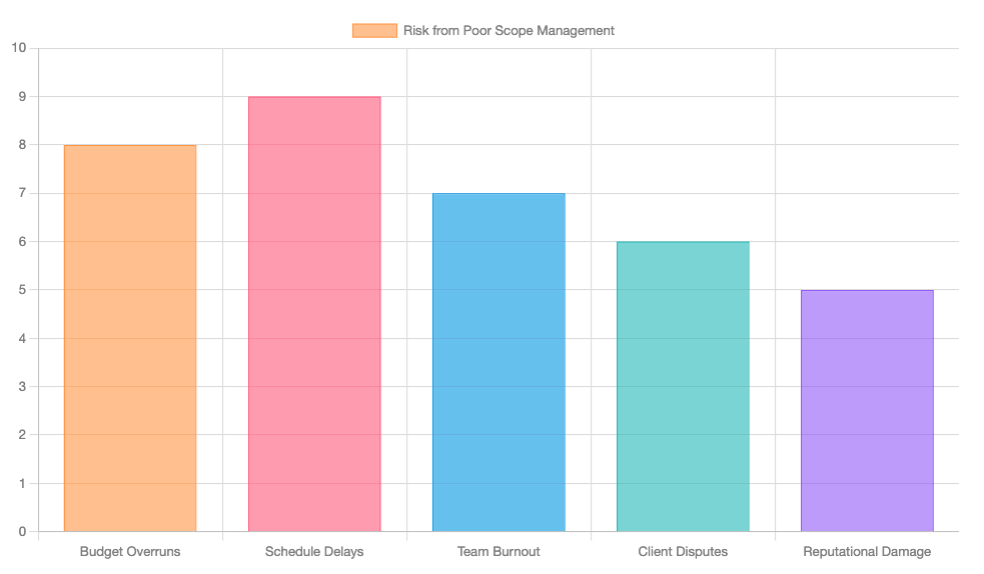
This bar chart illustrates the relative risks associated with poor scope management, ranked on a scale of 0 to 10, with 10 representing the highest risk.
Building a Culture That Resists Creep (and Embraces Clarity)
It's Not Just Tools, It's a Mindset
Finally, the best tool you have in your arsenal is your own team's mindset. Encourage your project managers to communicate early and often. Empower them to have frank, honest conversations with clients about scope and budget. Sometimes, the very best way to prevent creep is to be brave enough to say, "That's a great idea. Here's exactly what it will cost and how it will affect our deadline." It’s that perfect combination of clear initial documents, a rigorous process for managing changes, and a culture of transparency that truly locks down your project scope. You stop reacting and, instead, start controlling. And honestly, that’s how you transform potential disasters into well-managed, profitable projects.
Key Elements for a Strong Defense
This whole approach boils down to a few key areas, and it's amazing how interconnected they are. For instance, defining who can even issue change directives and how quickly they need a response is crucial. Setting clear markup caps for overhead and profit, separating field and home office costs, these things remove so much guesswork. Requiring contemporaneous records for time and materials tickets—think daily tickets, photos, delivery slips—this protects everyone. And don't forget to include a weather calendar and a baseline program so time impacts are based on real data, not just "vibes."
You know what? Documentation isn't just paperwork; it’s your story. Pictures are often better than memories, so tag photos to drawings and RFIs. Keep a meticulous change log with dates, causes, and approvals. When you eventually end up across the table from someone, a tidy log ends arguments fast. More than that, it actually builds trust.
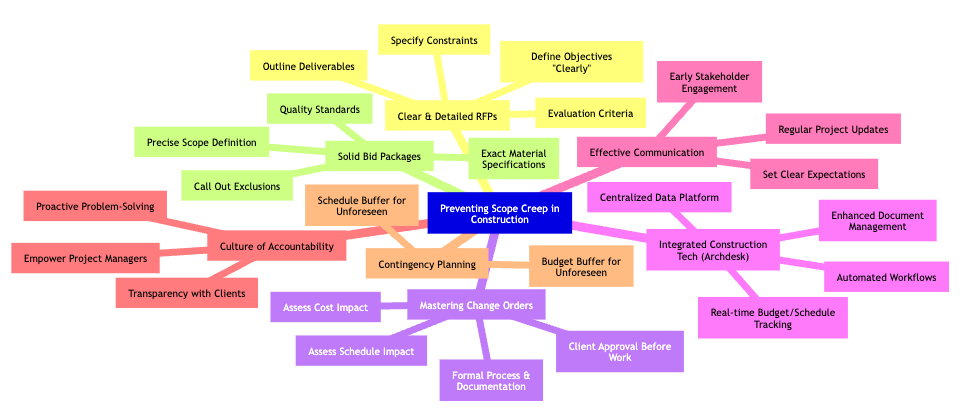
This mindmap visually summarizes the interconnected strategies for preventing scope creep in construction, from initial planning stages to ongoing project management.
The Power of Integrated Software: Archdesk Leads the Way
Connecting the Dots from Bid to Closeout
Plenty of platforms claim to fix these issues. Some do part of it, some just bury you in clicks. Archdesk, however, truly ties the entire chain together, from bid creation all the way to closeout, in one seamless place. That's what genuinely prevents scope creep.
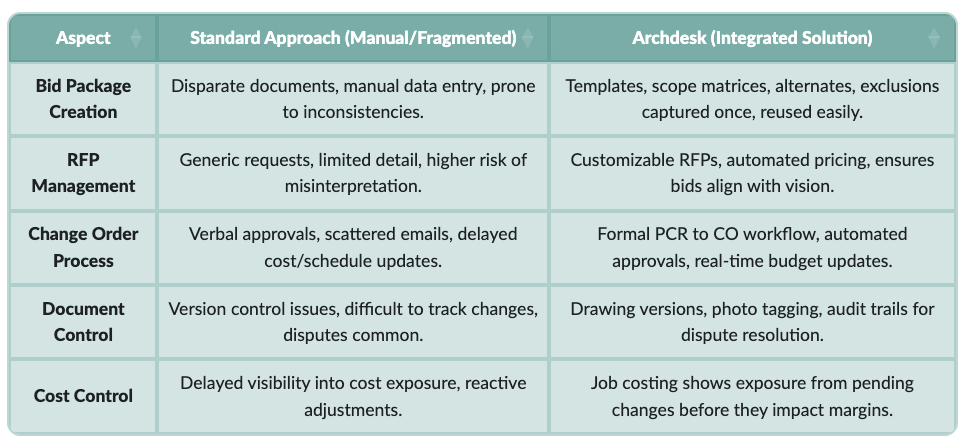
A comparison of typical project management practices versus the benefits of using an integrated platform like Archdesk to combat scope creep.
Why Archdesk Stands Out
- RFP and Bid Package Builder: It comes with templates, scope matrices, alternates, and exclusions, all captured once and easily reused.
- Estimating: Features cost catalogs, unit rates, and live links into subcontractor RFQs, ensuring quotes truly reflect the real scope.
- Change Order Workflows: Mirrors your contract—from Potential Change Request (PCR) to Change Order (CO), with automated approvals, versioned attachments, and real-time updates to contract values and budget lines.
- Document Management: Manages drawing versions, photo tagging, and robust audit trails that really stand up in disputes.
- Job Costing: Clearly shows exposure from pending changes even before they hit your margin.
While competitors like Procore have solid change tools, and Autodesk Construction Cloud is strong on models, and Buildertrend is friendly for smaller jobs, Archdesk provides that full, connected flow—from bid to CO to cost control—all in one system. It truly stays ahead because it's built to connect estimating, procurement, and project controls without bouncing data between modules. This integration is key to preventing those little cracks where scope creep can begin.
Regional Nuances and Quick Wins
Tailoring Strategies to Your Specific Context
Sometimes, regional quirks play a role too. In US public work, you need to watch statutory limits on change order percentages and strict written order rules. Over in the UK and EU, NEC and FIDIC mechanisms handle compensation events a bit differently, so you'll want to map your workflow to those specific clause numbers. And in the GCC, approvals can be notoriously swift or incredibly slow, making a clear CCD path and thorough T&M records your ultimate safety net.
Immediate Steps You Can Take
You can start making a difference this month! Add a one-page responsibility matrix to every bid package. Publish a clear change order markup sheet that everyone signs before the notice to proceed. Standardize a daily T&M ticket, complete with photos. Schedule that 15-minute weekly scope huddle and stick to it religiously. And of course, centralize it all in Archdesk so logs, costs, and documents stay perfectly aligned.
Scope creep isn't some monstrous entity. It’s simply unclear scope and unmanaged change. Write clearly, price honestly, document consistently, and let Archdesk keep all your threads connected. Less noise, more building. That's the goal, isn't it?
Frequently Asked Questions
What is scope creep in construction?
Scope creep happens when a project's requirements expand beyond the original agreement, often due to uncontrolled additions, leading to budget overruns and schedule delays.
Why are detailed bid packages important?
Detailed bid packages precisely define the project scope, materials, and quality standards, eliminating ambiguity and ensuring subcontractors bid on the same vision, thereby preventing unexpected changes.
How do RFPs help prevent scope creep?
Well-crafted RFPs clearly outline project objectives, deliverables, and constraints, helping to filter for partners who understand and respect the project boundaries from the outset.
What is a change order and how should it be managed?
A change order formally modifies the original contract to address changes in scope, cost, or schedule. It should be managed through a strict process of documentation, impact assessment, and approval before any work proceeds.
How does Archdesk help manage scope creep?
Archdesk provides an integrated platform that connects bid creation, RFP management, and change order workflows, offering real-time tracking, automated approvals, and centralized document control to maintain project scope and budget.
Conclusion
Managing scope creep effectively in construction isn't about avoiding all changes; it's about controlling them. By focusing on crystal-clear bid packages, precise RFPs, and a disciplined change order process, companies can build a robust defense against unforeseen costs and delays. The integration of powerful software like Archdesk becomes indispensable, connecting every phase of a project and fostering a culture of transparency and accountability. Ultimately, mastering these practices ensures projects remain on track, within budget, and profitable.
References
8 Best Construction Bidding Software (2025): A Comprehensive Guide ...
Scope Creep Explained: What It Is, Why It Happens, and ...
Controlling Cost Creep amid Construction Industry Challenges
Change Orders | Associated General Contractors of ...
Construction Bid Management Software | Archdesk
The 7 Best Construction Procurement Software Tools | Archdesk Blog
10 Best Construction Tender Software and Tools in 2025 | Archdesk Blog
Selecting Your Ideal Construction Management Software from Bid ...
RFP: What a Request for Proposal Is, Requirements, and a Sample





